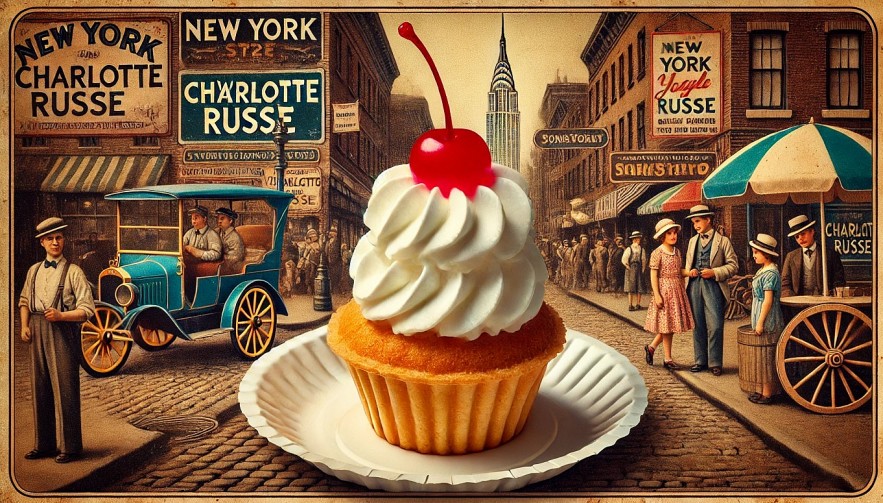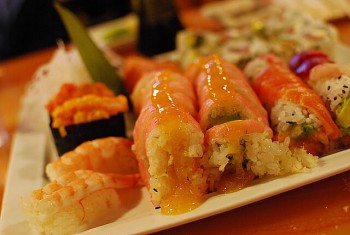Charlotte Russe Cake And Unique Variation in New York
The Charlotte Russe cake is a dessert that stands out with its unique combination of elegance, versatility, and rich history. A beloved treat in various forms, it has traveled through time and space, adopting cultural nuances along the way.
While its origins date back to 18th-century Europe, its modified form in New York is a fascinating chapter of culinary history, blending sophistication with the vibrant energy of a modern city.
What is a Charlotte Russe Cake?
 |
| A classic Charlotte Russe cake with an elegant vintage European presentation |
The Charlotte Russe cake is a dessert that combines sponge cake or ladyfingers with a mousse-like filling, often made from whipped cream, custard, or gelatin. Traditionally served in a cylindrical mold, the cake is distinguished by its light and creamy texture and its outer layer of delicate ladyfingers. It can be flavored with fruits, chocolate, or liqueurs, making it an adaptable dessert for different occasions.
Classic Composition:
Base: Ladyfingers or sponge cake arranged around a mold.
Filling: A rich cream or Bavarian mousse made with whipped cream, custard, and gelatin.
Top: Often garnished with fruits, chocolate, or nuts for added elegance.
In its modified New York version, however, the cake evolved into a single-serving dessert sold in paper cups, making it more accessible to the masses while retaining its signature flavors.
Origins of the Charlotte Russe
The origins of the Charlotte Russe cake trace back to the late 18th and early 19th centuries in Europe. The dessert is believed to have been invented by Marie-Antoine Carême, a famed French chef who was renowned for his elaborate pastries and desserts. Carême named the dessert after Queen Charlotte, the wife of King George III of England, and added "Russe" (Russian) to honor his Russian employer, Czar Alexander I.
European Influences:
• The traditional European Charlotte was more of a pudding-like dessert, served chilled and requiring meticulous preparation.
• The use of ladyfingers reflects the French tradition of creating layered desserts with delicate, sponge-like cakes.
Carême's original Charlotte was a luxurious dessert, meant to showcase culinary artistry and innovation. It gained popularity among European elites and was soon adapted into different styles across the continent.
The Evolution of Charlotte Russe in America
 |
| A nostalgic New York-style Charlotte Russe depicted as a street-side treat from the 1920s |
Arrival in New York
The Charlotte Russe made its way to the United States in the late 19th century, brought by European immigrants who introduced their culinary traditions to American cities. New York, as a cultural melting pot, quickly adopted the dessert. However, the classic European form was modified to suit the tastes and lifestyles of the city's burgeoning immigrant communities.
New York's Unique Twist
In New York, the Charlotte Russe underwent a transformation from an elegant, aristocratic dessert to an everyday treat that was affordable and accessible to working-class families. Instead of being served in a mold, the New York version was simplified into a small, portable dessert:
• Single Serving: Presented in a paper cup, with sponge cake at the bottom and whipped cream piped on top.
• Toppings: Often topped with a maraschino cherry for a burst of color.
• Affordability: Sold at bakeries, delis, and street carts for just a few cents in the early 20th century.
This adaptation made the Charlotte Russe a popular treat among children and families, particularly in Jewish and Italian neighborhoods.
Traditions and Significance
A Symbol of Accessibility
The transformation of the Charlotte Russe in New York highlights the city's ability to democratize even the most sophisticated culinary creations. What was once a symbol of European aristocracy became a nostalgic treat for the working class. It represented indulgence without extravagance—a small luxury in the hustle of city life.
A Staple of Urban Life
During its peak in the early to mid-20th century, the New York-style Charlotte Russe was a common sight in bakeries and street vendors across the city. It became a favorite treat for children after school, a quick dessert for office workers, and a nostalgic indulgence for older generations.
A Cultural Connection
For many New Yorkers, the Charlotte Russe became a reminder of simpler times. Immigrants and locals alike associated the dessert with community, warmth, and celebration, particularly during holidays or special occasions.
The Decline and Resurgence of Charlotte Russe
 |
| A modern reinterpretation of Charlotte Russe |
Decline in Popularity
By the mid-20th century, the Charlotte Russe began to fade from prominence in New York. Factors contributing to its decline included:
• Changing Tastes: The rise of more modern desserts like cheesecakes and cupcakes.
• Mass Production: The shift from handmade desserts to factory-made products.
• Urban Changes: The disappearance of small, family-owned bakeries that had once championed the dessert.
Modern Revival
In recent years, the Charlotte Russe has seen a resurgence as part of the broader trend of reviving nostalgic and vintage desserts. Artisanal bakeries and food historians in New York have begun reimagining the Charlotte Russe, giving it a modern twist while preserving its traditional essence:
• Upscale Variants: Incorporating exotic flavors like matcha, salted caramel, or passion fruit.
• Creative Presentations: Reintroducing the dessert in glass jars or decorative molds.
• Pop-Up Events: Hosting Charlotte Russe-themed events in homage to New York’s culinary history.
What Makes the Charlotte Russe Unique?
The Charlotte Russe stands out as a dessert with a dual identity. On one hand, it retains its roots in European sophistication and artistry. On the other hand, it reflects New York's ability to adapt and reinvent traditions, making the dessert both cosmopolitan and distinctly local.
Unique Characteristics:
• Cultural Fusion: Combines French, English, and Russian influences with a New York twist.
• Timeless Appeal: Appeals to both older generations for its nostalgia and younger audiences for its elegance.
• Versatility: Can be dressed up for formal occasions or simplified for casual enjoyment.
In New York, the Charlotte Russe embodies the city's ethos: a blend of old and new, tradition and innovation.
Conclusion
The Charlotte Russe cake is more than just a dessert—it is a symbol of culinary evolution, cultural adaptation, and the enduring appeal of sweetness in our lives. From its aristocratic beginnings in Europe to its humble reinvention in New York, the Charlotte Russe tells a story of innovation, resilience, and the power of food to connect people across time and place.
In New York, this dessert has become a nostalgic relic, a cherished memory for many who grew up savoring its simplicity and charm. As modern chefs and bakers bring it back into the spotlight, the Charlotte Russe continues to capture hearts with its timeless elegance and adaptability, proving that some traditions are simply too sweet to let go.
FAQs About Charlotte Russe Cake
1. What does "Charlotte Russe" mean?
The term "Charlotte Russe" combines two distinct references:
- "Charlotte": Named after Queen Charlotte of England, a patron of the arts and culture.
- "Russe": French for "Russian," in honor of Czar Alexander I of Russia, whom the dessert's creator, Marie-Antoine Carême, once worked for.
2. What are the key ingredients in a Charlotte Russe cake?
The classic Charlotte Russe cake typically consists of:
- Ladyfingers or Sponge Cake: Forms the base and outer layer.
- Whipped Cream or Bavarian Cream: Makes up the mousse-like filling.
- Gelatin or Custard: Used to stabilize the cream.
- Fruits or Chocolate: Often added as flavorings or toppings.
The New York version simplifies this with sponge cake, whipped cream, and a cherry on top.
3. Where did the New York version of Charlotte Russe originate?
The New York version of the Charlotte Russe cake is believed to have originated in immigrant neighborhoods in the early 20th century. It was popularized by bakeries and street vendors who adapted the European dessert into an affordable and portable treat for working-class families.
4. Is Charlotte Russe still popular today?
While the popularity of Charlotte Russe declined in the mid-20th century, it has seen a revival in recent years. Modern chefs are reimagining the dessert with new flavors and presentations, making it appealing to both nostalgic diners and those discovering it for the first time.
5. How is Charlotte Russe different from other desserts like tiramisu?
Although both desserts use sponge cake or ladyfingers, their flavors and preparations differ significantly:
- Tiramisu: Contains coffee, mascarpone cheese, and cocoa, and has a distinct Italian origin.
- Charlotte Russe: Focuses on whipped cream or custard fillings and has French and Russian influences.
The two desserts also vary in texture, as tiramisu is more moist and layered, while Charlotte Russe is typically firmer.
6. Can I make a Charlotte Russe at home?
Yes! Making a Charlotte Russe at home is quite simple if you have the right ingredients. You can use store-bought ladyfingers or bake your own sponge cake. Whipped cream or custard forms the filling, and you can get creative with flavors like chocolate, vanilla, or fruit. Many modern recipes also offer gelatin-free options.
7. What makes the New York-style Charlotte Russe unique?
The New York-style Charlotte Russe is unique because it transforms an elegant European dessert into a portable, single-serving treat. Its paper cup presentation and simple yet delicious combination of sponge cake, whipped cream, and cherry made it a street food favorite for decades.
8. Is Charlotte Russe a seasonal dessert?
While the dessert can be enjoyed year-round, its light and airy texture make it particularly popular during warmer months. Some variations, such as fruit-flavored Charlottes, are associated with summer, while richer versions with chocolate or liqueur are perfect for festive holidays.
9. What are some modern twists on the Charlotte Russe?
Modern interpretations of the Charlotte Russe include:
- Exotic Flavors: Matcha, passion fruit, or salted caramel fillings.
- Vegan Versions: Using plant-based cream and gelatin substitutes.
- Layered Jars: Replacing the traditional mold with glass jars for an Instagram-friendly presentation.
10. Where can I find Charlotte Russe in New York today?
Artisanal bakeries and specialty dessert shops in New York City are beginning to revive the Charlotte Russe as part of the vintage dessert trend. You can also find recipes online to recreate this nostalgic treat at home.
11. Why did Charlotte Russe decline in popularity?
The decline of Charlotte Russe was due to several factors:
- Changing dessert trends in the mid-20th century.
- The rise of factory-made cakes, which overshadowed handmade desserts.
- The disappearance of small, family-run bakeries that traditionally made the dessert.
12. What is the cultural significance of Charlotte Russe in New York?
The New York-style Charlotte Russe represents the city’s melting-pot culture, where European traditions were adapted to fit the lifestyle of working-class immigrants. It’s a symbol of nostalgia, community, and the creativity of immigrant bakers who made luxurious desserts accessible to everyone.
 The World's Top 15 Countries With The Greatest Cuisine The World's Top 15 Countries With The Greatest Cuisine Many nations draw tourists because of their delicious and diverse cuisine. Which nation's cuisine do you enjoy the most? |
 10 Least Favorite Foods in the US But The Rest Of The World Love 10 Least Favorite Foods in the US But The Rest Of The World Love The culinary tastes of the United States are as varied as the country itself. From their favorite store-bought products to the best chocolate chip cookie ... |
 Top 13 Best Vietnamese Restaurants In New York City Top 13 Best Vietnamese Restaurants In New York City Interested in sampling Vietnamese cuisine in New York? Refer to our comprehensive guide to determine the optimal choice that is favored by both local residents ... |
 Top 10 Best Turkish Restaurants In The United States Top 10 Best Turkish Restaurants In The United States Locating a Turkish restaurant in the United States is challenging. Identifying a suitable one has become increasingly challenging. We are here to assist you in ... |























